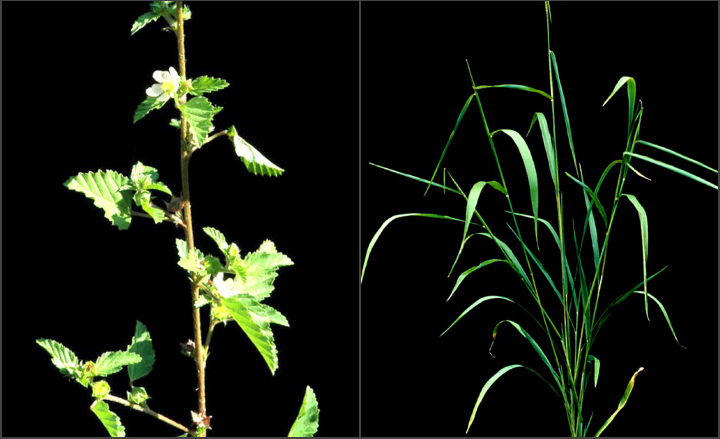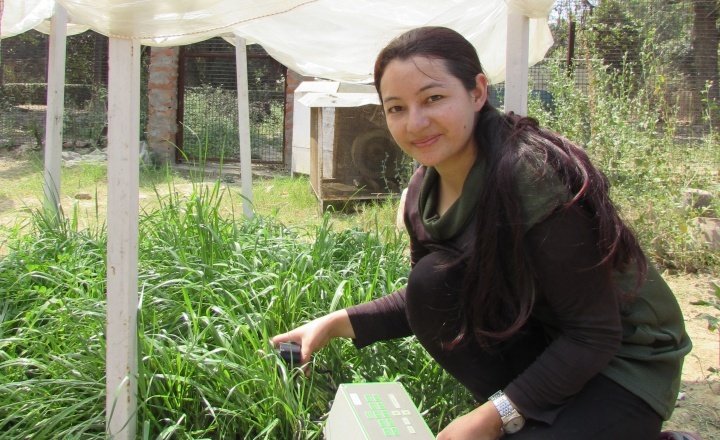Ozone, the gas best-known for protecting us from the ultraviolet rays of the sun, can turn harmful if produced in excess quantities by human activities. A team of researchers from the Banaras Hindu University have studied the effect of elevated ozone on plants that inhabit the lush grasslands of central India.

In a recent study, Madhoolika Agrawal and her research team from the Banaras Hindu University have assessed the effect of ozone pollution on a pair of herbaceous plants which grow prominently in the grasslands and open areas in Varanasi, Uttar Pradesh. By simulating the ozone concentration expected in the year 2050, the researchers show that although both grassland species will be negatively affected by an increase in ozone concentration, the magnitude of the impact and strategies for survival will vary between the two.
Ozone (O3) — a gas comprising molecules of three oxygen atoms each — acts as both a saviour and enemy for life on earth. While a layer of ozone gas high up in the earth’s atmosphere protects us from the damaging effect of ultraviolet rays in sunlight, excess ozone in the lower layers of the atmosphere (troposphere) can be harmful to human, animal, as well as plant health.
In humans, for example, high ozone levels can trigger a range of health issues such as throat irritation, coughing, chest pain, bronchitis, asthma etc. In plants, ozone can enter the leaves through tiny openings called stomata and damage the tissue within.
Ozone in the troposphere is usually formed as a result of human activities. Ozone precursors are fed into the atmosphere by pollutants released from vehicles, industries, boilers, chemical plants, refineries etc. In the presence of light, these give rise to ozone through a series of chemical reactions.

Studies have shown that Central India and the Indo-Gangetic plains have significantly high ozone levels due to high industrial and vehicular pollution. Further, these lands are effectively locked in by the Himalayas creating a valley effect in the region which does not allow the polluted air to dissipate easily. By the year 2050, ozone levels are projected to increase by 20 – 40%. Although many studies have been conducted to understand the effect of rising ozone on crop plants, its effect on the wild or grassland species of Indo-Gangetic plains remains unknown.
“Grassland vegetation plays an important role in carbon sequestration, ozone deposition, the beauty of the natural landscape, food for herbivores, and in many other ecosystem services,” says Agrawal. She and her team decided to assess the responses of two different grassland species to the projected future levels of ozone concentration in the atmosphere. The plants they chose were a grass called Ischaemum rugosum Salisb (saramollagrass) and a forb (a type of herbaceous plant with broad leaves) named Malvastrum coromandelianum Garcke (called Suchi in Hindi).
The researchers grew the chosen plants in chambers where they were exposed to high ozone levels to simulate the conditions they will face in the year 2050. Next, they assessed the growth of the plants and other stress-related symptoms under such conditions.
The team found that though the growth of both species was negatively affected by high ozone levels, the effect was more pronounced in the forb. Both plants responded to elevated ozone by producing chemicals which can neutralize the oxidizing effect of ozone. However, they used different chemicals to perform this task — ascorbic acid and tannin for Malvastrum, proline and other phenolics for Ischaemum. The researchers also found that under ozone stress, Ischaemum closes off its stomata, but Malvastrum leaves them open, making it more susceptible to ozone accumulation and resulting damage.
The team speculates that this makes it more likely that Ischaemum would dominate the grassland community in the future, given its better adaptation to high ozone concentrations.
“Researchers working on ozone-tolerant plant species always wonder about the defence response mechanism of plants. This study concludes that the defence response of plant species to ozone stress is species-specific and lies in the genetic makeup of the plant species,” says Dheeraj Rathore, Assistant Professor at the Central University of Gujarat, who was not associated with the study.
Agarwal’s team is now planning to conduct long-term studies on other grassland species of tropical areas under elevated ozone levels. These studies may lead to a better understanding of the impact of changing atmospheric conditions on the sustainability of tropical grassland ecosystems.